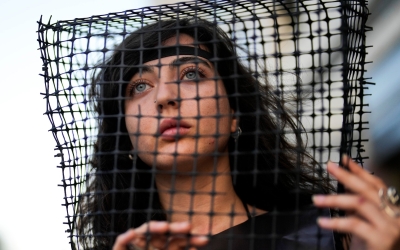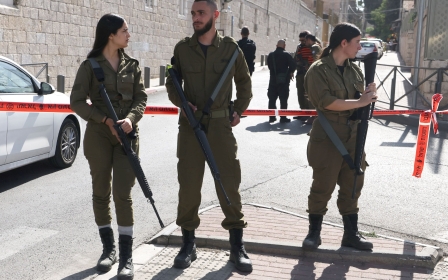Israel-Palestine war: Israel's army advances in Gaza’s open areas to avoid repeating 2014 mistakes

Israel’s ground invasion of the Gaza Strip is now becoming a siege operation, as Israeli troops tentatively advance in a pincer movement to surround Gaza City.
After three weeks of ferocious bombardment, Israeli soldiers entered the coastal enclave overnight on 27 October from the north and the east.
The military is being coy about the number of troops involved and their objectives, but it has acknowledged that artillery, tanks, and bulldozers have accompanied infantry and special forces, in an offensive dubbed "Operation Iron Swords".
So far, the advance has been made through agricultural lands and sparsely populated urban areas, indicating the Israeli military is avoiding clashes with Palestinian fighters in residential areas at this stage.
However, it has no qualms about bombing heavily residential areas and a raid on the Jabalia refugee camp on Tuesday killed around 100 people.
New MEE newsletter: Jerusalem Dispatch
Sign up to get the latest insights and analysis on Israel-Palestine, alongside Turkey Unpacked and other MEE newsletters
More than 9,000 Palestinians, including more than 3,760 children, have been killed by the Israeli bombardment over the last four weeks.
The ground invasion was launched after intense shelling of less built-up areas close to the separation fence on the boundary between Gaza and Israel, specifically near the Palestinian towns of Beit Lahia in the northwest, and Beit Hanoun in the northeast.
However, Israeli troops are still far from the tunnels belonging to Hamas’ armed wing, the Izz al-Din al-Qassam Brigades, and other armed groups.
Israel began its assault on Gaza following the 7 October Hamas-led attack that killed around 1,400 Israelis and says it wants to remove Hamas from the enclave.
Pressure is growing domestically to prioritise freeing the 240 captives taken by Palestinian fighters during the attack. It is believed the captives are being held in tunnels across the Gaza Strip.
Follow our live blog for all the latest on the Israel-Palestine war
An Israeli source familiar with the situation told Middle East Eye that the first of the two objectives of the ground operation’s initial phase had been achieved.
These were the creation of buffer zones in areas where the risk of coming under attack is low, as well as the establishment of bases to support further operations.
"The first objective has been realised. We now have bases along the strip that can support our operational areas. This establishing of bases took place in relatively safe areas in the north and east of the strip," the Israeli source said.
The second stage of the ground offensive will be to connect the pockets of Israeli control, impose a total siege on Gaza City, and slowly extend Israeli-held territory, he added.
So far, Israeli troops have pushed into Gaza from the east along the Johr al-Dik axis, cutting northern Gaza - including Gaza City - off from the enclave’s south and severing the main Salah al-Din and al-Rasheed roads that Palestinians have been using to flee south.
They are also advancing along the coast southwards on the Beit Lahia axis, almost reaching the outskirts of Gaza City.
Limited advances have also been made around Beit Hanoun in the northeast.
"Operationally, the army is advancing on three lines, countering terrorist attacks in the planned direction so far. The convergence of two of these lines is enough to trap terrorist targets in a specific area, allowing the operation to move towards more precise targets," the Israeli source said.
Previous lessons
Turkish security sources that are closely following the war in Gaza said that it appears Israel has learned a lot from past ground offensives in the enclave, and were now following a carefully planned roadmap.
"Israel's Operation Iron Swords is like a copy of operations in 2009 and 2014, but they avoid repeating the mistakes they made in the past," a Turkish source told MEE, speaking anonymously due to restrictions on speaking to the press.
The source added that Israel is moving slowly to avoid serious trouble, which indicates a certain tactical pattern.
In 2009's Operation Cast Lead, 13 Israeli soldiers were killed as the military moved into densely populated areas. Similarly, in 2014's Operation Protective Edge, 66 Israeli soldiers were killed during operations in residential areas.
'A repetitive pattern has emerged to avoid mistakes. The Palestinians may have also realised this'
- Turkish source
According to the Turkish source, Israel was not ready for such an operation and has so far only moved into open areas and the urban communities overlooking them.
“A repetitive pattern has emerged to avoid mistakes. The Palestinians may have also realised this,” he said.
“The Israeli army enters the area, identifies enemy firing positions and targets, and quickly withdraws. Next, air strikes follow. Then, the armored troops and infantry advance. This model will not work as they move into the cities."
The last time Israel staged a ground offensive in Gaza was in 2014, which was known as Operation Protective Edge and lasted for three weeks.
Rich Outzen, a retired US colonel, said that in this operation Israel was unable to penetrate the tunnel system and the main areas used by Hamas and other groups.
Outzen described today’s Operation Iron Swords as more comprehensive than in 2014, with more extensive joint maneuvering between forces.
"[They are] more focused on the tunnel network itself, with [the] apparent intention to go into the heart of Gaza City and stay long enough to render the tunnels unusable,” he told MEE.
“It is not wrong to consider this a siege of sorts, as opposed to what amounted to punitive raids in 2014."
Israeli advance dictated by Gaza factions
Israel has advanced about 6km along the northwest coastline around Beit Lahia and has reached the southeast of Netzarim and al-Zeitoun from its advance around Johr al-Dik.
The Israeli army, which often tries to expand its operation area from north to south and from east to west, still has direct access to urban areas.
Turkish sources believe that the idea that Israel is advancing rapidly is misleading.
"This advance is shaped by the preferences of the armed groups in Gaza rather than Israel's capabilities and planning,” the Turkish source said.
“It is clear that the Palestinian groups prefer a residential clash in which they can use the population in their favour, rather than an open battle. In other words, the Israeli army’s advance is the Gaza factions' choice, not Israel's. Israel is currently avoiding an urban war."
However, despite this, the Israelis are still taking losses.
Israel says it has lost 24 soldiers so far in the ground offensive, and on Thursday the Qassam Brigades released a video purportedly showing two of its fighters damaging an Israeli tank in a daring close-range raid.
Israel intends to make northern Gaza the primary battleground for now. On 13 October, it warned the million Palestinians living in Gaza’s north to flee south or risk death, though it has also heavily bombed areas that it told people to escape to.
Israel has also recently dropped leaflets in the northern part of Wadi Gaza, which the Israelis have designated as the border between Gaza’s north and south, ordering people to leave their homes.
Turkish sources think the longer the operation drags on, the more Israel will lose its ability to direct the war, despite its technical superiority.
Yet according to Outzen, the current strategy is the only option open to Israel if it wants to continue prosecuting the war with its aim of crushing Hamas.
This article is available in French on Middle East Eye French edition.
Middle East Eye delivers independent and unrivalled coverage and analysis of the Middle East, North Africa and beyond. To learn more about republishing this content and the associated fees, please fill out this form. More about MEE can be found here.






